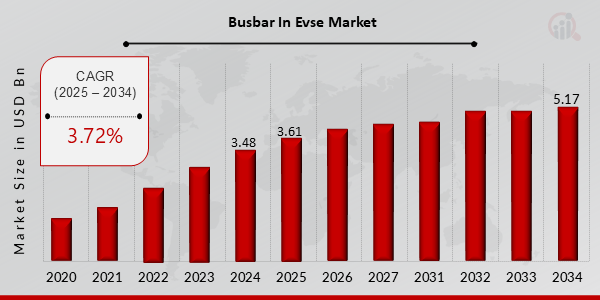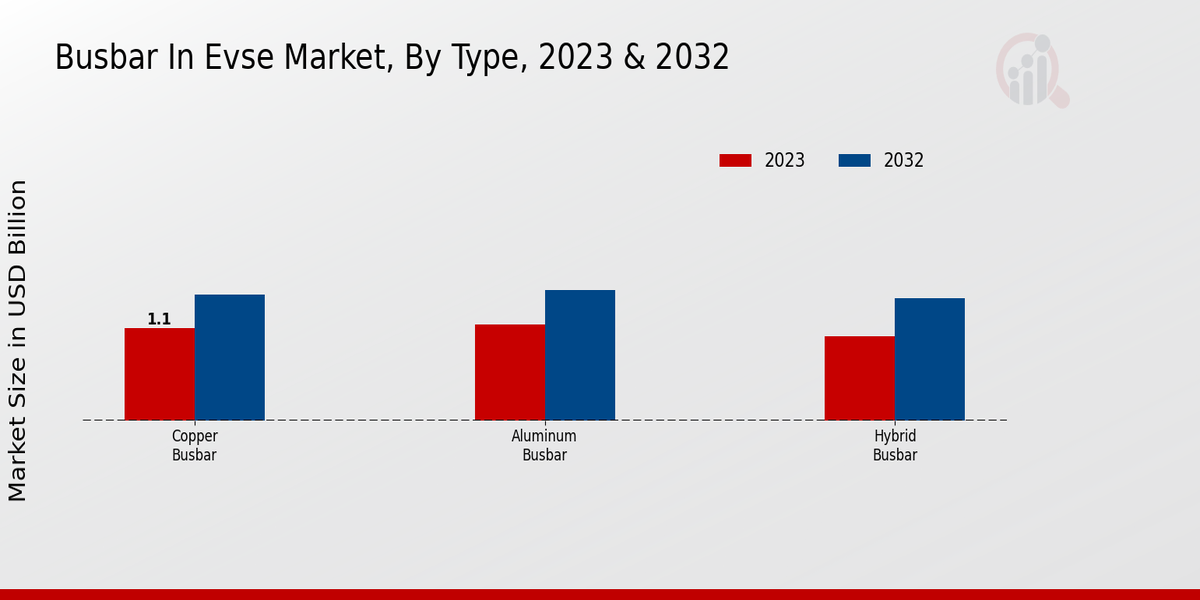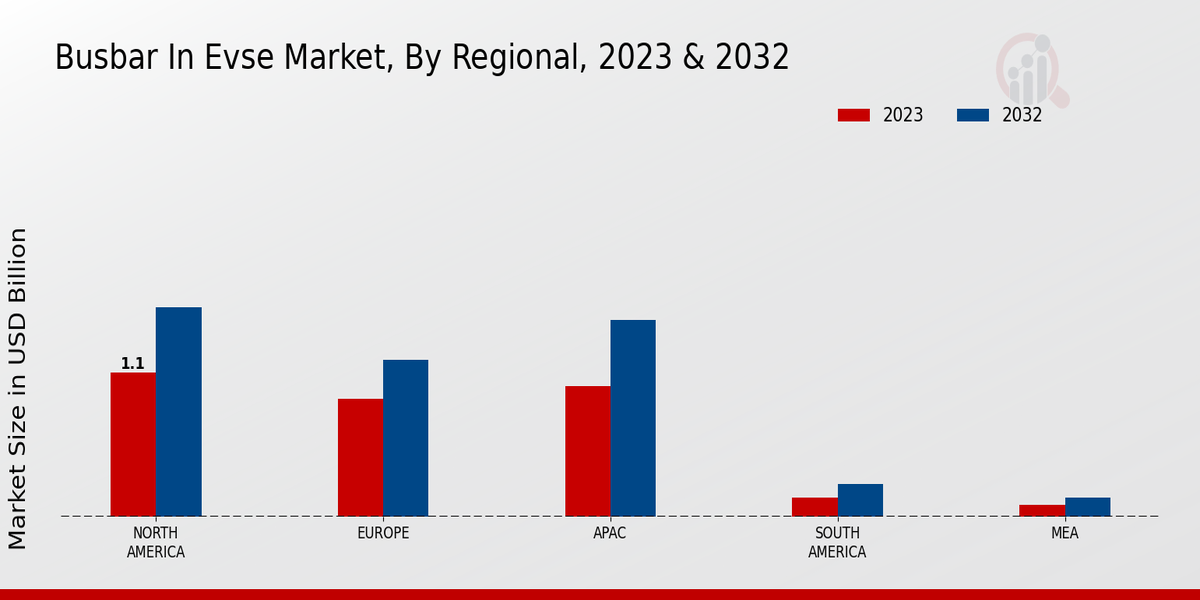Global Busbar in EVSE Market Overview
Busbar In Evse Market Size was estimated at 3.48 (USD Billion) in 2024. The Busbar In Evse Market Industry is expected to grow from 3.61 (USD Billion) in 2025 to 5.17 (USD Billion) till 2034, exhibiting a compound annual growth rate (CAGR) of 3.72% during the forecast period (2025 - 2034)
Key Busbar in EVSE Market Trends Highlighted
The Global Busbar in the EVSE market is experiencing notable growth driven by several key market drivers. The increasing adoption of electric vehicles, spurred by growing environmental awareness and government incentives, is a significant factor. As more companies and consumers shift towards electric mobility, the demand for reliable and efficient energy distribution systems becomes crucial. Enhanced charging infrastructure is needed to meet the needs of electric vehicles, creating a necessity for sustainable solutions like busbars that facilitate the effective transmission of electricity. Furthermore, advancements in technology and innovation in manufacturing processes are enabling the development of busbar systems that are both cost-effective and efficient, thus promoting their wider use in electric vehicle supply equipment.
The opportunities within the market are expanding as urban areas push for clean transportation solutions. Innovations in renewable energy sources, like solar and wind, present chances for integrating busbar systems that can handle variable loads and support distributed energy resources. Additionally, as smart city initiatives evolve, incorporating advanced technologies into busbar designs can capture further market potential. Providers can explore partnerships and collaborations to introduce integrated solutions, promoting efficiency in energy distribution and supporting the growth of EV infrastructure. Recent trends indicate a shift towards more modular and scalable busbar solutions that can easily adapt to evolving energy demands.
There is a growing focus on sustainability and energy efficiency, prompting companies to seek environmentally friendly materials and processes. The emphasis on safety and reliability in the design of busbars, in conjunction with regulatory support for EV charging infrastructure, aligns with market needs. Moreover, the rise of electric fleet management systems is likely to influence busbar design, ensuring that these systems meet the needs of both fleet operators and public charging stations, reinforcing their role in the broader EV ecosystem.

Source: Primary Research, Secondary Research, MRFR Database and Analyst Review
Busbar in EVSE Market Drivers
Growing Demand for Electric Vehicles
One of the primary drivers of growth in the Busbar in EVSE Market Industry is the increasing demand for electric vehicles (EVs). As environmental concerns continue to rise, both consumers and governments worldwide are focusing more on sustainable transportation options. This shift towards EVs significantly boosts the need for efficient and effective charging infrastructure, including busbars, which are critical for the operation of Electric Vehicle Supply Equipment (EVSE).With more countries implementing stricter emission regulations and policies promoting the adoption of EVs, the market for busbars that support charging stations is expected to experience significant growth. As manufacturers invest in infrastructure to cater to the rising number of electric vehicles on the road, the need for advanced busbar systems becomes more pronounced.
These systems facilitate high-power distribution, ensuring that electric vehicles can charge quickly and efficiently.The evolution of technology in the EV space, coupled with legislative incentives for electric vehicle adoption, continues to enhance the overall Busbar in EVSE Market Industry. Increased electric vehicle adoption not only leads to greater investment in EV charging stations but also necessitates the use of modern busbar technology which is designed to handle the specific demands of a rapidly growing electric vehicle market. The energy transition globally towards cleaner alternatives is further solidifying the role of busbars in supporting this infrastructure.
Government Initiatives and Support
Government initiatives aimed at promoting electric mobility are another key driver influencing the Busbar in EVSE Market Industry. Various governments around the world have introduced subsidies, tax incentives, and grants to encourage the installation of EV charging stations. These initiatives often culminate in increased funding for organizations involved in the manufacture and implementation of busbars, which are vital for the functioning of EV infrastructure.Moreover, the commitment to reducing greenhouse gas emissions leads to a greater reliance on electric vehicles, ultimately boosting the demand for efficient busbar solutions.
Technological Advancements in Busbar Systems
The pace of technological advancements in busbar systems is driving the Busbar in EVSE Market Industry. Innovations in materials, design, and manufacturing processes have made busbars more efficient, durable, and capable of handling higher currents. As technology progresses, the integration of smart systems for load management and monitoring becomes feasible, further enhancing the utility of busbars in EVSE infrastructure. This evolution not only improves performance and reliability but also aligns with the growing need for scalable solutions to accommodate the increasing number of electric vehicles.
Busbar in EVSE Market Segment Insights
Busbar in EVSE Market Type Insights
The Busbar in EVSE Market has been observing significant revenue growth, with a projected overall valuation of 3.24 USD Billion in 2023, rising to 4.5 USD Billion by 2032. This market is important as it encompasses various types, notably Copper Busbar, Aluminum Busbar, and Hybrid Busbar, which are essential components in Electric Vehicle Supply Equipment (EVSE) infrastructure. Among these, Copper Busbar holds a notable position with an estimated valuation of 1.1 USD Billion in 2023 and is expected to reach 1.5 USD Billion by 2032. This sub-segment influences due to copper's superior electrical conductivity and reliability, making it a preferred choice for high-performing charging stations.Aluminum Busbar, valued at 1.14 USD Billion in 2023 and anticipated to grow to 1.55 USD Billion by 2032, is dominating the market.
This type offers cost-effectiveness and lightweight advantages, appealing to many EV charging solutions opting for more economical and weight-efficient materials. The shift towards higher efficiency at lower costs drives its relevance within the market. Lastly, Hybrid Busbar stands at a valuation of 1.0 USD Billion in 2023, projected to rise to 1.45 USD Billion by 2032. This sub-segment combines the advantageous features of both metals, leveraging the conductivity of copper with the affordability of aluminum, catering to a diverse range of applications in the EVSE sector.
The distribution of valuations demonstrates that the majority holding within the market belongs to Copper and Aluminum Busbars, reflecting their established roles in the EV charging infrastructure. As the world progresses towards electrification, the Busbar in EVSE Market is placed favorably, driven by trends such as increasing EV adoption, technological advancements, and a shift towards renewable energy sources, all contributing to the compelling market growth potential.

Source: Primary Research, Secondary Research, MRFR Database and Analyst Review
Busbar in EVSE Market Installation Type Insights
The Busbar in EVSE Market encompasses various installation types, primarily categorized into indoor and outdoor installations. In 2023, the overall market is valued at 3.24 billion USD, reflecting the growing demand for efficient electrical distribution systems amid the rise of electric vehicles. Indoor installations play a crucial role as they are often essential for residential and commercial charging stations, harnessing the need for compact and efficient designs. On the other hand, outdoor installations dominate due to the increasing deployment of public charging infrastructure, which is vital for enhancing EV accessibility.
The significant growth of both installation types is driven by the accelerating adoption of electric vehicles and the ongoing transition towards sustainable energy solutions. The Busbar in EVSE Market revenue is expected to witness upward trends as urban areas expand their charging networks, presenting opportunities for innovation and improvements in technology. However, challenges such as regulatory compliance and environmental concerns must be addressed for sustained market growth. Insights from the Busbar in EVSE Market data reflect a robust framework set to support this dynamic segment, showcasing its influence in the overall industry.
Busbar in EVSE Market Application Insights
The Busbar in EVSE Market's Application segment showcases a robust landscape poised for growth, with the overall market expected to be valued at 3.24 USD Billion in 2023. Charging stations stand out as a vital component, catering to the rising demand for electric vehicles, providing efficient power delivery for quicker charging solutions. The Distribution Network also plays a significant role, ensuring the effective transfer of electricity, crucial for sustaining the increasing load from EV infrastructure.
Renewable Energy Integration is gaining prominence, especially as the focus shifts towards sustainable energy sources, aligning with global efforts to reduce carbon emissions.Furthermore, Commercial Buildings serve as major contributors by incorporating advanced charging solutions, reflecting a growing trend towards electrification in urban areas. Collectively, these applications drive the market's momentum, highlighting the necessity for efficient power solutions as the industry expands. With a projected growth trajectory, the Busbar in EVSE Market segmentation points to strategic opportunities across various applications, supported by consistent advancements in technology and infrastructure requirements.
Busbar in EVSE Market End Use Insights
The Busbar in EVSE Market is significantly influenced by various End Use applications, which include key areas such as Residential, Public Transportation, and Fleet Management. In 2023, the overall market was valued at 3.24 USD billion, reflecting a robust interest in the growth of electric vehicle charging infrastructure. Residential applications are critical, as they contribute to the increasing demand for home charging stations, allowing electric vehicle owners to charge conveniently. Public Transportation plays a pivotal role as well, with electric buses gaining traction, driving the necessity for dependable busbar systems.
Furthermore, Fleet Management is emerging as a major segment, where companies seek efficient charging solutions for their electric fleets, enhancing operational sustainability and reducing costs. Collectively, these areas contribute to the steady expansion of the Busbar in EVSE Market revenue, driven by growing environmental awareness and advances in electric vehicle technology. Market trends indicate a strong push towards integrating smart technologies, which presents opportunities alongside challenges such as regulatory compliance and infrastructure readiness, influencing the Busbar in EVSE Market data and statistics as the industry continues to evolve.
Busbar in EVSE Market Regional Insights
The Regional segment of the Busbar in EVSE Market showcases significant diversity in its market value and growth potential across different areas. In 2023, North America leads with a notable valuation of 1.1 USD Billion, contributing majorly to the market growth due to advancements in electric vehicle infrastructure and government incentives. Europe follows closely with a valuation of 0.9 USD Billion, driven by robust regulations promoting sustainable transportation. The APAC region, valued at 1.0 USD Billion in 2023, demonstrates significant promise owing to increasing electric vehicle adoption and urbanization trends.
South America and MEA represent smaller segments, valued at 0.15 USD Billion and 0.09 USD Billion respectively in 2023, yet present growth opportunities as these regions start investing in EV infrastructure. The overall dynamics of the Busbar in EVSE Market revenue reveal that while North America and Europe currently dominate, APAC's growth trajectory suggests a shift in market prominence. Such disparities emphasize the importance of regional strategies tailored to varying infrastructure capabilities and market readiness, essential for tapping into the opportunities within the Busbar in EVSE Market industry.

Source: Primary Research, Secondary Research, MRFR Database and Analyst Review
Busbar in EVSE Market Key Players and Competitive Insights
The Busbar in EVSE Market is a rapidly evolving sector that is critical to the electrification of transportation and the growing demand for electric vehicle charging infrastructure. As the transition to electric vehicles accelerates worldwide, the need for efficient and reliable electrical distribution systems is becoming increasingly important. The competitive landscape in this market is characterized by numerous players striving to enhance their product offerings and establish a strong foothold in order to capture the growing demand for electric vehicle supply equipment. Innovation, technological advancements, and strategic partnerships play a significant role in shaping the competition, as companies seek to develop solutions capable of meeting the requirements of modern EV charging systems while ensuring optimal performance and safety.
Busbar Technologies is a prominent player in the Busbar in EVSE Market, focusing on innovative solutions that cater to the unique demands of electric vehicle charging systems. The company has established a significant market presence by prioritizing high-quality manufacturing processes and exceptional service offerings. Their strengths lie in the design and production of flexible busbar systems that are tailored for various applications in the EVSE space, emphasizing reliability, efficiency, and ease of installation. The ability to deliver customized solutions has enabled Busbar Technologies to build strong relationships with clients and partners, positioning them well in a market that increasingly values adaptability in its technological offerings.Mersen is another key contender in the Busbar in EVSE Market, recognized for its extensive expertise in electrical protection and advanced material solutions.
The company benefits from a broad product range that includes various busbar configurations designed to support the infrastructure needs of electric vehicle charging stations. Mersen's strengths stem from its commitment to research and development, enabling them to innovate continually and respond effectively to changing market demands. Their global reach and ability to provide high-performance products that emphasize safety, durability, and energy efficiency have made Mersen a sought-after partner in the EV supply equipment landscape. Together with a robust supply chain and customer-centric approach, Mersen reinforces its presence as a reliable player in the burgeoning EVSE sector.
Key Companies in the Busbar in EVSE Market Include
- Busbar Technologies
- Mersen
- Kirby Risk
- Legrand
- Mitsubishi Electric
- Grote Industries
- Eaton
- General Electric
- Phoenix Contact
- ABB
- Rittal
- Schneider Electric
- Siemens
- Chint Electrics
- Delta Electronics
Busbar in EVSE Market Industry Developments
The Global Busbar in Electric Vehicle Supply Equipment (EVSE) Market has witnessed several pivotal developments recently. Companies such as ABB, Eaton, and Schneider Electric have made strides in enhancing their busbar technologies to support the growing demand for efficient electric vehicle charging solutions. In terms of mergers and acquisitions, notable activity has surfaced with Mersen acquiring a division from a competitor to expand its product offerings and market reach. Meanwhile, Mitsubishi Electric has announced the launch of innovative busbar systems aimed at improving electrical performance and reducing installation costs.
The market valuation for companies such as General Electric and Siemens has seen positive momentum, attributable to the surging investments in EV infrastructure and sustainable energy initiatives. This growth not only underscores the increasing integration of electric vehicles into the transportation sector but also highlights the role of reliable busbar systems in facilitating efficient power distribution for EVSE. Furthermore, advancements in technology by firms like Phoenix Contact and Legrand have led to enhanced products, driving market competitiveness and innovation. The ongoing developments reflect a proactive stance by industry players to meet the evolving needs of the electric vehicle charging ecosystem.
Busbar in EVSE Market Segmentation Insights
-
Busbar in EVSE Market Type Outlook
- Copper Busbar
- Aluminum Busbar
- Hybrid Busbar
-
Busbar in EVSE Market Installation Type Outlook
- Indoor Installation
- Outdoor Installation
-
Busbar in EVSE Market Application Outlook
- Charging Stations
- Distribution Network
- Renewable Energy Integration
- Commercial Buildings
-
Busbar in EVSE Market End Use Outlook
- Residential
- Public Transportation
- Fleet Management
-
Busbar in EVSE Market Regional Outlook
- North America
- Europe
- South America
- Asia Pacific
- Middle East and Africa
|
Report Attribute/Metric
|
Details
|
|
Market Size 2024
|
USD 3.48 Billion
|
|
Market Size 2025
|
USD 3.61 Billion
|
|
Market Size 2034
|
USD 5.17 Billion
|
|
Compound Annual Growth Rate (CAGR)
|
3.72% (2025-2034)
|
|
Base Year
|
2024
|
|
Market Forecast Period
|
2025-2034
|
|
Historical Data
|
2020-2023
|
| Market Forecast Units |
USD Billion |
|
Report Coverage
|
Revenue Forecast, Competitive Landscape, Growth Factors, and Trends
|
| Key Companies Profiled |
Busbar Technologies, Mersen, Kirby Risk, Legrand, Mitsubishi Electric, Grote Industries, Eaton, General Electric, Phoenix Contact, ABB, Rittal, Schneider Electric, Siemens, Chint Electrics, Delta Electronics |
| Segments Covered |
Type, Installation Type, Application, End Use, Regional |
| Key Market Opportunities |
Increased electric vehicle adoption, Rising demand for fast-charging solutions, Growth in renewable energy integration, Advancements in busbar technology, Expansion of charging infrastructure |
| Key Market Dynamics |
Growing EV adoption, Infrastructure investment, Technological advancements, Cost reduction strategies, Government regulations |
| Countries Covered |
North America, Europe, APAC, South America, MEA |
Frequently Asked Questions (FAQ) :
The Busbar in EVSE Market is expected to be valued at 5.17 USD Billion by the year 2034.
The expected CAGR for the Busbar in EVSE Market from 2025 to 2034 is 3.72%.
North America is anticipated to hold the largest market share, valued at 1.6 USD Billion in 2032.
Copper Busbar is expected to be valued at 1.5 USD Billion in the Busbar in EVSE Market by 2032.
Major players in the market include companies like ABB, Siemens, and Schneider Electric.
The Aluminum Busbar segment is expected to reach a market value of 1.55 USD Billion by 2032.
The Busbar in EVSE Market is valued at 3.24 USD Billion in the year 2023.
The APAC region is expected to grow from a market value of 1.0 USD Billion in 2023 to 1.5 USD Billion in 2032.
Key trends include rising demand for electric vehicles and advancements in busbar technology to enhance efficiency.
The Hybrid Busbar segment is projected to be valued at 1.45 USD Billion by the year 2032.

















